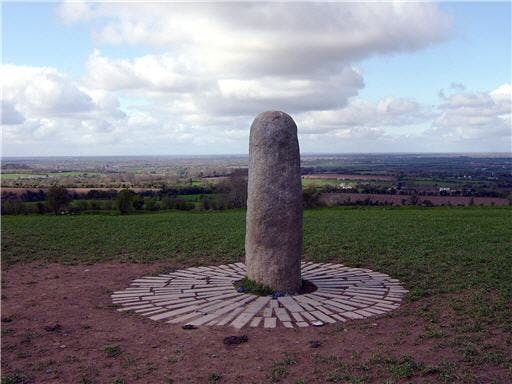Hill of Tara
Stories of Ireland
Story by Korinn Braden
The Hill of Tara is home to a blessed peoples, ceremonial monuments dating to 3000 B.C., Kings of Ireland, historic battles, and the demands and ravages of the 21st century. A few years ago a proposal was made to extend a pre-existing motorway between Enniskillen in Northern Ireland and Dublin, the M3. The proposed extension directly affects this monument to Ireland’s history. This proposal has many supporters and detractors. The debate of retaining one’s cultural heritage versus continued development is tricky. Who can discount the hours of gridlock traffic and delays? But the loss on one’s cultural heritage and identity is nothing to be just paved over.

View from the Hill of Tara
The Hill of Tara is about thirty miles north of Dublin, situated in the Tara-Skryne Valley in County Meath. The hill was once ruled by the pagan and the early Kings of Ireland. Tara’s status helped dictate the political, cultural, and religious practices of Ireland. Over time, the councils held at Tara brought way to fairs, including market activities and athletic competitions.
The founders of the Hill of Tara are said to be the Túatha De Danann, or the peoples of the goddess Danú. They are also said to have descended from the northern skies to Ireland. With them they brought treasures from their four mystical cities. At this point it’s interesting to note the migration of the Celts, from East to West. Certain Celtic god and goddess names have parallels to Aegean gods as well as the gods of the European Continent. Of the four treasures brought, the Stone of Destiny, or Lía Fáil, is still present.
The Stone of Destiny “told” others when a king of Ireland was present. The stone was said to roar when the rightful king of Ireland touched it. One hundred and forty-two kings were crowned here. Again, it’s interesting to think of the other legends concerning stones and kings. Legend says a stone from Tara was brought to Scotland, then to Westminster Abbey, where it is still on exhibit. This Stone of Scone was used in the coronation of British monarchy. Or have you heard the one about Arthur, a sword, and a stone?

Stone of Destiny
Early Christianity was brought to Ireland by a few people, however St. Patrick is the most famous. It is said he lit an unlawful fire on a certain night to gain the attention of a king. His mission, in a number of ways, was successful. He was brought before the king, thusly initiating the king’s conversion to Christianity and in fact, Ireland.
The 200th anniversary of the Battle of Tara was recently observed, in which the Irish were defeated by the British. Or right around the bend was the infamous Battle of the Boyne, again resulting in defeat. In the mid-1880s an activist for the Catholic Emancipation gathered close to a million supporters on the Hill of Tara to call for the restoration of the Irish Parliament. Despite the losses and setbacks, the Irish still consider this land part of the nation’s identity.
The Hill of Tara is roughly the size of three football fields and years of successive archaeological investigations continue to yield finds. In order for the proposed M3 extension to stay on budget and track, a diversion around the site is improbable.
Maybe Arthur’s Merlin can work some magic…
Many thanks to:
Delaney, Mary Murray. Of Irish Ways. Minneapolis, Minnesota: Dillon Press, 1973.
McColman, Carl. The Complete Idiot’s Guide to Celtic Wisdom. Indianapolis, Indiana: Alpha Books, 2003.
All Photos by Graham MacMahon, 2005.
